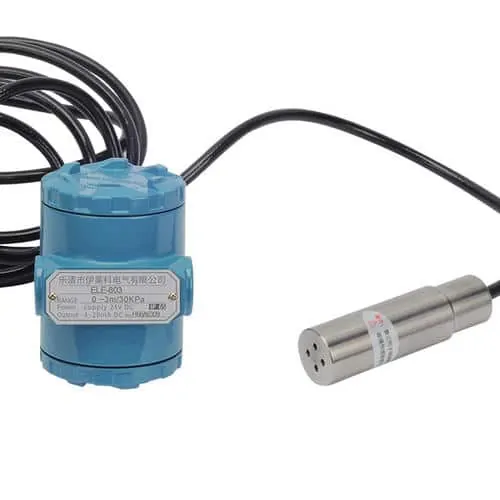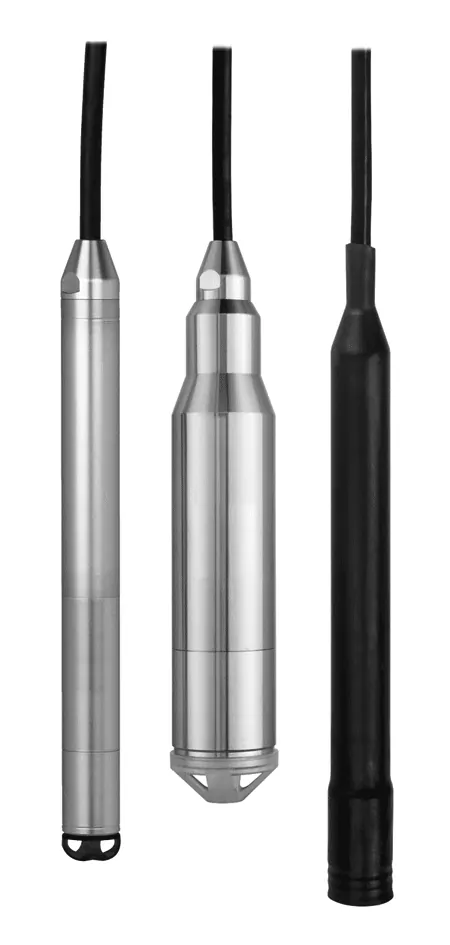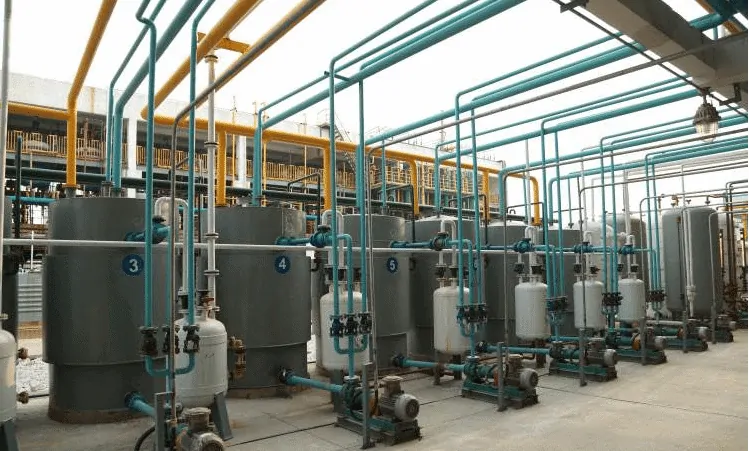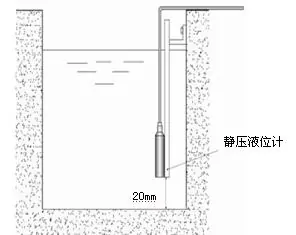Hydrostatic Level Sensor (Best Price), also called Hydrostatic level transmitter. Continuous level measurement in liquid applications with pressure sensors.

Hydrostatic Level Sensor measures the hydrostatic pressure by the submersible pressure sensor. The static pressure of the liquid is proportional to the height of the liquid. Then the static pressure was converted into an electrical signal. Convert to analog signal output or 4-20mADC. With digital display. For water level measurement, hydrostatic level sensor is a low cost type. Different types of measuring cells are used in level measurement based on the hydrostatic principle.
Lightning protection, anti-corrosion, explosion-proof optional. IP68 is optional.
Sino-Inst offers a variety of Hydrostatic Level sensors for industrial level measurement. If you have any questions, please contact our sales engineers.
Features of Hydrostatic Level Sensor

Standards:
- CE
- FCC
- RoHS compliant
- China RoHS
- Level measurement with hydrostatics is totally unaffected by foaming or vessel installations
- Ceramic measuring cells offer excellent long-term stability and high overload resistance
- Metallic measuring cells also cover larger measuring ranges
- Level/depth measurement
- 4 to 20 mA or digital (S3L) output
- Flush ceramic diaphragm
- Easy submersible installation
- Choice of two pressure ranges
- Standard union connection and extended cable and capillary tubing 10 m (32.8 ft)
Best Price from
Hydrostatic Level Sensor Manufacturer
Specifications of Hydrostatic Level Sensor
| Measurement form and range | 0 ~ 1 ~ 200mH2O |
| Allow overload | 2 times full scale pressure |
| Operating temperature | -20 ~ 80 ℃ |
| Temperature compensation | -10 ~ 70 ℃ |
| storage temperature | -40 ~ 80 ℃ |
| Accuracy (including nonlinearity, repeatability, hysteresis) | 0.2% FS (typical) 0.5% FS (maximum) |
| Stability error | 0.2% FS (typical), 0.5% FS (maximum) |
| Temperature drift coefficient | 0.01% FS (typical, range is not less than 5mH2O), 0.03% FS (typical, range is less than 5mH2O) |
| output signal | (4 ~ 20) mA (two / three wire system), (0 ~ 10/20) mA, (0 ~ 5) V, (1 ~ 5) V,) 0 ~ 10) V |
| Power supply | 15 ~ 36 VDC (calibration voltage 24VDC) |
| Load (Ω) | Current output type <(U-15V) /0.02A, current output type> 5K |
| Shell material | Aluminium Alloy |
| O-ring | fluoro rubber |
| Diaphragm | 316L stainless steel |
| cable | Special waterproof breathable cable |
| Protection level | IP68 (pressure sensor part), IP65 (junction box transmitter part) |
If you need more than 200meters, please refer to Deep Wells Water level sensor.
If you measure less than 5meters, you can also check the Hydrostatic level transmitter-Rod Type.
Applications of Hydrostatic Level Sensor
Hydrostatic level sensors measure the pressure generated by a static head of liquid. Use hydrostatic level sensors to measure fluid levels in Tanks. And applications like storage tanks, processing vessels, header tanks, pump inlet heads, and others. Hydrostatic pressure is used to determine the liquid height.

- Inventory Management
- Storage Tank Monitoring
- Neutralization Tanks
- Plating Lines
- Waste Sumps
- Clarifiers
- Overflow Protection
If you need a liquid level sensor with longer service life, you can refer to Magnetostrictive level sensor
Hydrostatic level measurement: Measuring Principle
The basic working principle of Hydrostatic Level Sensor is static pressure level measurement.
In liquid, the pressure generated at a certain depth is generated by the weight of the medium itself above the measurement point. It is proportional to the density of the medium and the local acceleration of gravity.
The formula P = ρgh reflects the proportional relationship between them.
Where P = pressure, ρ = medium density, g = gravity acceleration, h = depth of measurement point.
Therefore, the physical quantity measured by the input liquid level gauge is actually pressure. It can be understood by the calibration unit mH2O of the input level gauge. The actual liquid level must be obtained by conversion after knowing the two parameters of density and gravity acceleration. In the industrial field, such conversion is usually performed by a secondary instrument or PLC.
The Hydrostatic Level Sensor mainly measures corrosive liquids such as hydrochloric acid, hydrogen peroxide, etc. Or chemical and electroplating wastewater. Mainly used in measuring corrosive media. It has the advantages of strong corrosion resistance and stable performance.
Let’s see how does a hydrostatic level sensor work ?
Video source: https://www.youtube.com/watch?v=T2OPoEod_jM&feature=emb_logo
What is a hydrostatic gauge? Or, What is a hydrostatic level sensor?
Hydrostatics is the science of fluids not in motion.
A hydrostatic level sensor is a form of a level probe, that is used especially for level monitoring, by measuring the hydrostatic pressure, in a virtually static liquid at a pre-determined level of submersion.
A hydrostatic level sensor is a submersible pressure transmitter, that has a pressure diaphragm, where the inner side of the diaphragm is vented to atmospheric pressure, through a vent tube in the cable, and the outer side is in contact with the liquid, and measuring the static pressure of the liquid column above the transmitter.
This static pressure is basically caused by the weight of the fluid on top of the transmitter, and is used to calculate the level of the liquid.


Read more about: Differences! Static pressure vs dynamic pressure vs total pressure
How does a hydrostatic level sensor work? Or How is hydrostatic pressure measured?
When considering a new level sensor for level measurement applications, it is often hard to find information on how the different types of level sensors, like the hydrostatic level sensors respectively hydrostatic pressure sensors, are working.
Recently, I explained level measurement by using the hydrostatic pressure measurement.
In closed geometries, such as enclosed tanks and vessels, generally, flush pressure sensors or pressure transmitters are used, which can be screwed into the vessel from the outside.
Pressure sensors are therefore particularly suitable, in applications of free-standing tanks and vessels.
A submersible pressure transducer or a flush pressure sensor measures the height-dependent weight-force of the liquid column, also known as hydrostatic pressure.
This pressure measurement is directly proportional to the liquid level respectively liquid column, at the measuring point of the pressure sensor.
It is, therefore, necessary, for the measurement of level, that the pressure sensor is placed as close as possible to the level of the vessel’s bottom.
The measured hydrostatic pressure then directly corresponds to the height of the liquid column, from the ground-level measurement point to the surface level of the medium.
So, the filling height is calculated from the distance of the medium surface to the measuring point by the pressure measurement.
The weight force of the liquid column, thus the hydrostatic pressure, however, is not only directly proportional to the filling height but also varies with the specific gravity of the medium and the force of gravity.
Extended reading: Hydrostatic Pressure Transmitter
Hydrostatic level sensor in use
The simplicity of using a hydrostatic level sensor makes it the instrument of choice wherever level needs to be measured, no matter if in a vented tank, vessel, lake, river, or reservoir.
In most cases, it is suspended by the cable to the desired level of measurement, or just submerged and allowed to sink to the bottom of the resource.
It does not matter what the structure of the tank, basin, or natural geometry is or if it has any obstructions, ledges, or complex shape, a hydrostatic level sensor will always measure the pressure of the liquid unaffected by such disturbances.
As the hydrostatic level sensor commonly is a gauge pressure sensor, it automatically compensates for the atmospheric pressure changes, so the pressure measured represents only the pressure of the liquid, caused by the liquid’s specific gravity and the vertical distance to the surface.
Therefore, the hydrostatic level sensor accurately measures the level of the liquid, by calculating the distance from the measuring point to the surface level via the measured pressure.
A hydrostatic level sensor may be calibrated in the meters water column to allow for standard gravity or local gravity.
For very high accuracy level monitoring often the temperature of the media may also be considered to take the temperature effects on the specific gravity into account.
The hydrostatic level sensor is a specialized sensor for level monitoring, most commonly used in the water and wastewater industry.
Its simple use and reliable and accurate measurement technology make it one of the most commonly used level sensors by far.
Extended reading: Capacitive water level sensor
FAQ
How does a hydrostatic level sensor work?
The hydrostatic level sensor is based on the principle that the measured static pressure of the liquid is proportional to the height of the liquid. It is made with an advanced isolated diffused silicon sensitive element or a ceramic capacitive pressure sensitive sensor. The static pressure is converted into an electrical signal. After temperature compensation And linear correction. Converted into a standard electrical signal (generally 4 ~ 20mA / 1 ~ 5VDC). The hydrostatic level sensor can also be called “static pressure liquid level gauge, liquid level transmitter, liquid level sensor, water level sensor”.
Read more about: What Is A Submersible Level Transducer?
How is hydrostatic pressure measured?
The hydrostatic pressure can be measured by a pressure sensor.
Principle of hydrostatic pressure measurement:
When the liquid level transmitter is put into a certain depth in the liquid to be measured, the pressure on the liquid-facing surface of the sensor.
The formula is: ρ = ρ .g.h + po
In the formula:
p: pressure on the liquid face of the transmitter
ρ: measured liquid density
g: local gravity acceleration
PO: atmospheric pressure on the liquid surface
h: the depth of the transmitter into the liquid
At the same time, the pressure of the liquid is introduced into the positive pressure chamber of the sensor through the air-conducting stainless steel. Then connect the atmospheric pressure PO on the liquid surface to the negative pressure chamber of the sensor. To offset so on the back of the sensor, the pressure measured by the sensor is: ρ .g.h. Obviously, by measuring the pressure p, the liquid level depth can be obtained.
Extended reading: Static pressure vs dynamic pressure vs total pressure
What is the hydrostatic level sensor?
A hydrostatic pressure level sensor (Submersible Level Transmitter) is a pressure sensor that measures liquid level based on the principle of static pressure measurement. It can also be called “static pressure liquid level gauge, liquid level transmitter, liquid level sensor, water level sensor”
What is the water level sensor?
The water level sensor is an instrument that can convert the water level parameter of the measured point into the corresponding power signal in real time. It is mainly composed of a fully sealed isolation membrane oil-filled sensor and a built-in high-performance microprocessor.
There are many types of water level sensors. There are three common types of ultrasonic liquid level sensors, servo liquid level sensors, and static pressure liquid level sensors. Due to the differences in their working principles and performance, their applications are also different.
What is the ultrasonic level sensor?
The ultrasonic level sensor is a non-contact liquid level sensor. Ultrasonic sensors are sensors developed using the characteristics of ultrasound. Ultrasound is a mechanical wave with a vibration frequency higher than that of sound waves, which is generated by the vibration of the transducing wafer under the excitation of voltage. It has high frequency, short wavelength, and small diffraction phenomena. In particular, it has good directivity and can be ray and directional propagation. Ultrasound has a great ability to penetrate liquids and solids. Especially in the opaque solids of sunlight, it can penetrate a depth of tens of meters.
What is meant by hydrostatic pressure?
Hydrostatic pressure refers to the pressure on the surface of an object when it is stationary or moving at a uniform speed. Its unit is pa. Static pressure plus dynamic pressure equals total pressure.
In fluid mechanics, it mainly refers to the following three types:
The pressure is generated by the fluid at rest.
The pressure is perpendicular to the direction of fluid movement when the fluid is flowing.
The gauge pressure value is measured in the fluid without being affected by the flow velocity.
Sino-Inst offers over 10 Hydrostatic Level Sensors. About 50% of these are Submersible Level Sensors, 40% are water level meters, and 40% are liquid treatment.
A wide variety of Hydrostatic Level Sensor options are available to you, such as free samples, paid samples.
Sino-Inst is a globally recognized supplier and manufacturer of Hydrostatic Level Sensor instrumentation, located in China.
The top supplying country is China (Mainland), which supply 100% of
Hydrostatic Level Sensor respectively.
Sino-Inst sells through a mature distribution network that reaches all 50 states and 30 countries worldwide.
Hydrostatic Level Sensor products are most popular in Domestic Market, Southeast Asia, and Mid East. You can ensure product safety by selecting from certified suppliers with ISO9001, ISO14001 certification.
Request a Quote

Wu Peng, born in 1980, is a highly respected and accomplished male engineer with extensive experience in the field of automation. With over 20 years of industry experience, Wu has made significant contributions to both academia and engineering projects.
Throughout his career, Wu Peng has participated in numerous national and international engineering projects. Some of his most notable projects include the development of an intelligent control system for oil refineries, the design of a cutting-edge distributed control system for petrochemical plants, and the optimization of control algorithms for natural gas pipelines.
